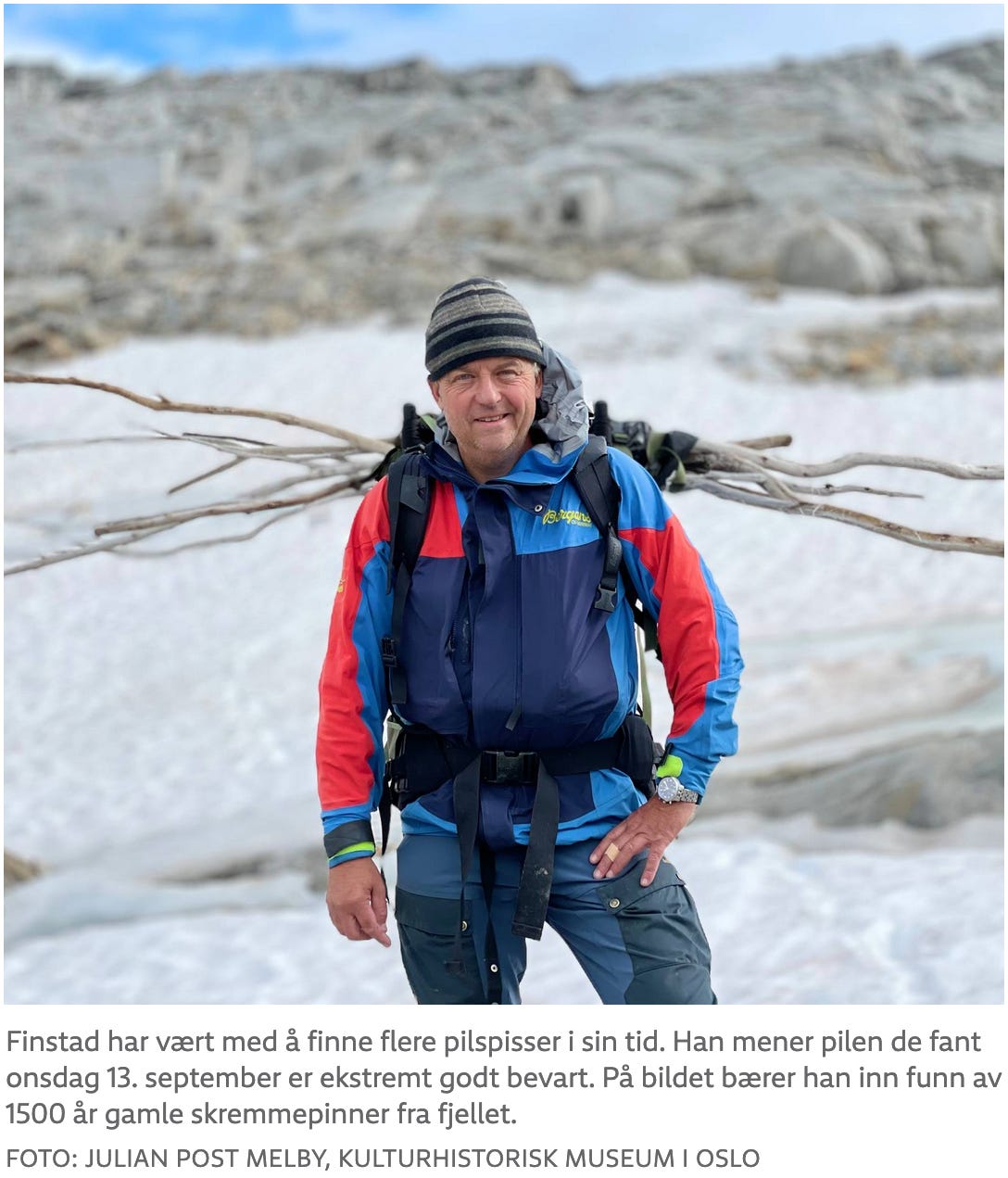Where Once Glaciers Rested, Archaeologists Literally Stumble Across Artefacts
Another day, another spectacular finding by Norwegian researchers
Reference is made to my most recent posting:
These days, it seems that all archaeologists need to to is—take a hike uphill. Today, I’ll bring you more awesome and exciting news in this regards, this one is courtesy of NRK, Norway’s state broadcaster.
As always, translation, emphases, and bottom lines mine. This time, I reproduce some images due to the (honestly awesome) artefacts; credit as cited.
New Unique Item From the Bronze Age: ‘It doesn't get much better than this’
A 3,600-year-old arrow with a river mussel arrowhead has been found in the ice in Jotunheimen. Archaeologists believes it has been preserved exceptionally well.
By Mette Finborud Børresen, Mette Vollan, and Ann-Kristin Mo, NRK, 16 Sept. 2023 [source]

Can you believe it! We've just found an incredibly well-preserved arrow with a river mussel arrowhead. It looks like it was lost last year, but the arrow is around 3,600 years old, from the early Bronze Age! It doesn't get much better than this!
This is the joyful message from the ‘Secrets of the Ice’ team on Facebook.
‘Your Heart Rate Goes Up’
The arrow was found right underneath the ice edge at a known location in the north-east of the Jotunheimen mountain range.
Espen Finstad is a glacier archaeologist in Innlandet County Council. He was present when the arrow was discovered on Wednesday this week:
Your heart rate goes up a few extra notches when you see an arrow shaft lying there. We quickly realised that it was a rare type that was extremely well preserved.

The ‘Secrets of the Ice’ team has been involved in glacier archaeology in the Norwegian Inland since 2006.
‘Secrets of the Ice’ is a collaboration between Innlandet County Council and the Museum of Cultural History in Oslo.
They have found a couple of hundred arrows from prehistory. This is the fourth arrow they have found of this type. In total, only eight such arrows are known nationwide.
‘This is clearly the best preserved. The degree of preservation is exceptional," says Finstad.
Arrowhead Made of Mussels
The arrowhead is made from river mussels. This is the fourth arrow we have found that is made from it. There are a total of eight known discoveries nationwide. Elsewhere in the world, river mussels are only known to be used in North America. [more mysteries…how cool is that!]
In this case, it is not only the arrowhead that is well preserved, but also the organic material with wooden shafts and lashings has survived well.
Finstad says that this gives them a completely different insight into how things were done in prehistory.
The discovery has attracted a lot of attention and is of international interest.
Finstad adds that they haven’t finished their search and he doesn’t rule out the possibility of finding more: ‘The ice of the glaciers is melting more and more, and ancient artefacts are constantly coming to light.’
The finds we make on the ice are generally getting older and older every year. The ice is melting fast due to climate change. Now it's the really old ice that's melting. [no good deed goes unpunished: why invoke ‘climate change’?]
In Lom, Norway's oldest shoe has also melted. Three years ago, archaeologists found the skeleton of a dog between Lom and Skjåk.

At the Norwegian Mountain Centre in Lom, 100 of the most beautiful finds from the ice are on display in the exhibition ‘Frose i tid’ [frozen in time]:
Here you can see Norway’s oldest shoe, the dog from Lendbreen, and arrows that are up to 6,100 years old, including the rare tips of river mussels.
Bottom Lines
As the world gets warmer (again), archaeologists go hiking and surveying higher into the mountains. Lo and behold, they now literally stumble across these awesome artefacts.
As I wrote in the last dedicated piece (linked above), sadly the archaeological community is a member of the Cult of Latter Day Saint Greta, hence their inability to see the meaning of these findings, which I think is the following:
The world was warmer in the past than it is today, which is evidenced, e.g., by ice-free Alpine peaks as recently as 3,350 years ago (see here).
Humans went up on mountain ranges and passes quite frequently as recently as some 500 years ago, if evidence from Norway is any guide (see here).
As the world warms up today, more glaciers are melting, showing that the melting is ‘really old’ (eldgammelt), which means some 3,350 years old or the like. Put differently, there was no ice cover there before, hence the human artefacts archaeologists and hikers are literally tripping over almost every time they go hiking.
This should be headline news and required reading for the apostles of ‘climate doom’, for I think they have quite a bit of ‘splainin’ to do.
Let’s see if we’ get some more news like the above before too long; the odds for yet more spectacular findings are quite high.




I could not stop laughing when I saw the photo of the Greta cult archaeologist carrying the bundle of sticks.
Look up the definition of a 'bundle of sticks' in English. Then, look for the slang translation of the word. Sometimes the universe presents the most hilarious moments.
I've never understood, why the glaciers were environmentally sacrosanct.
They were held up as evidence of humanity's crimes against nature. Their slow melt, our Scarlett letter! 🤔Strange, particularly when one considers how mountains, rivers, oceans, islands, continents, etc are all made over millennia- constantly moving, ebb and flow. So why are the glaciers required to be static? Held up as a symbol of our trangressions🤔🤔😐🤦♀️